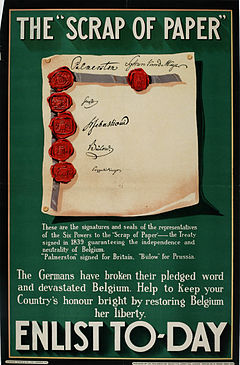- Treaty of London (1839)
-
The Treaty of London, also called the First Treaty of London or the Convention of 1839, was a treaty signed on 19 April 1839 between the European great powers, the United Kingdom of the Netherlands and the Kingdom of Belgium. It was the direct follow-up of the 1831 'Treaty of the XXIV Articles' which the Netherlands had refused to sign. Under the treaty, the European powers recognized and guaranteed the independence and neutrality of Belgium and confirmed the independence of the German speaking part of Luxembourg. Its main historical significance was Article VII, which required Belgium to remain perpetually neutral, and by implication committed the signatory powers to guard that neutrality in the event of invasion.
Contents
Territorial consequences
Since 1815, Belgium had been a part of the United Kingdom of the Netherlands. With the treaty, the southern provinces of the Netherlands became internationally recognized as the Kingdom of Belgium (which it was de facto since 1830), while the province of Limburg was split into Belgian and Dutch parts.
The same happened to the Grand Duchy of Luxemburg which lost two-thirds of its territory to the new Province of Luxembourg in what is termed the 'Third Partition of Luxembourg'. This left a rump Grand Duchy, covering one-third of the original territory and inhabited by one-half of the original population,[1] in personal union with the Netherlands, under King-Grand Duke William I (and subsequently William II and William III). This arrangement was confirmed by the 1867 Treaty of London,[2] known as the 'Second Treaty of London' in analogy to the 1839 treaty, and lasted until the death of King-Grand Duke William III 23 November 1890.[3]
Zeeuws-Vlaanderen was detached from Belgium as well and became part of the Dutch province of Zeeland because the Dutch did not want Belgium to have co-control of the Scheldt estuary. In return they had to guarantee the free navigation on the Scheldt into the Port of Antwerp.
Iron Rhine
The Treaty of London also guaranteed Belgium the right of transit by rail or canal over Dutch territory as an outway to the German Ruhr. This right was reaffirmed in a May 24, 2005, ruling of the Permanent Court of Arbitration in a dispute between Belgium and the Netherlands on the railway track.
In 2004 Belgium requested a reopening of the Iron Rhine. This is the result of the increasing transport of goods between the port of Antwerp and the German Ruhr Area. As part of the European policy of modal shift on the increasing traffic of goods, transport over railway lines and waterways is preferred over road transport. The Belgian request was based on the treaty of 1839, and the Iron Rhine Treaty of 1873. After a series of failed negotiations, the Belgian and Dutch governments agreed to take the issue to the Permanent Court of Arbitration and respect its ruling in the case.
In its ruling of May 24, 2005, the court acknowledged both the Belgian rights under the cessation treaty of 1839 and the Dutch concerns for the nature reserve. The 1839 treaty still applies, the court found, giving Belgium the right to use and modernize the Iron Rhine. However, it has to finance the modernization of the line, while the Netherlands have to fund the repairs and maintenance of the route. Both countries will split the costs of the construction of a tunnel beneath the nature reserve.
Chiffon de papier
Belgium's de facto independence had been established through nine years of intermittent fighting, the Belgian Revolution. The signatories of the treaty, the United Kingdom, Austria, France, Prussia, Russia, and the Netherlands, now officially recognised the independent Kingdom of Belgium, and at the United Kingdom's insistence agreed to its neutrality.
The treaty was an important document, especially in its role in bringing about World War I. When the German Empire invaded Belgium in August 1914 in violation of the treaty, the British declared war on August 4. Informed by the British ambassador that Britain would go to war with Germany over the latter's violation of Belgian neutrality, German Chancellor Theobald von Bethmann Hollweg exclaimed that he could not believe that Britain and Germany would be going to war over a mere 'scrap of paper' (French: chiffon de papier).
In reality, the German invasion led to Britain's decision to go to war for reasons that were felt in Britain to be more significant: it was considered inconceivable that Germany, with her expanding navy, should be allowed to control Belgium's sea ports. On August 2, Kaiser William II unsuccessfully asked General Moltke to cancel the invasion in order to keep Britain out of the war.
The German armies also invaded Luxembourg at the same time, whose neutrality had been guaranteed by the great powers under the Treaty of London (1867).
See also
Footnotes
References
- Calmes, Christian (1989). The Making of a Nation From 1815 to the Present Day. Luxembourg City: Saint-Paul.
- (French) Kreins, Jean-Marie (2003). Histoire du Luxembourg (3rd edition ed.). Paris: Presses Universitaires de France. ISBN 978-21-3053-852-3.
External links
Categories:- Treaties of the United Kingdom
- History of Luxembourg (1815–1890)
- Belgian Revolution
- Causes of World War I
- 1839 in Austria
- 1839 in France
- 1839 in the United Kingdom
- 1839 in Belgium
- 1839 in Luxembourg
- Treaties of the Austrian Empire
- Belgium–Netherlands border
- Belgium–Luxembourg border
- 1839 treaties
- Treaties of the July Monarchy
- Treaties of the United Kingdom of the Netherlands
- Treaties of the Kingdom of Prussia
Wikimedia Foundation. 2010.

